Chocolate: Why it Says More than ‘I Love You’

With Valentine’s Day right around the corner, now would be a good time (not that there’s ever a bad time) to talk about chocolate. Besides the many great tasting varieties it comes in, chocolate also has a variety of health benefits.
HEART HEALTH
Not only can it be a key to a person’s heart but it can also be good for it too. This sweet treat contains a compound known as flavonols, which have been shown to have cardiovascular benefits such improving circulation, lowering blood pressure and cholesterol.
MOOD ENHANCER
Dark chocolate contains the chemical compound phenylethylamine which has been shown to improve mood. When consumed it also increases the release of endorphins in the brain which also has been shown to boost one’s feelings.
NOT ALL CHOCOLATE CHALKS UP
While some studies have shown health benefits resulting from chocolate consumption, it doesn’t mean necessarily you should have a candy bar or eat chocolaty goods more often. Truth is, not all chocolate is created equal. Choose dark chocolate or cocoa powder that has not been highly processed over milk chocolate or other chocolate bars and candies that are typically high in calories, fat, and added sugar. The less processed the chocolate the more likely it will have higher levels of flavonols and antioxidants for health benefits. Another key is moderation with most research suggesting around a single ounce serving of dark chocolate several times per week. Any more than that and you run the risk of fewer health benefits and more added calories and sugar in the diet.
Looking for the Best in Health Drinks? Try Water

With the summer season fast approaching, many are also working back into exercise routines in hopes to obtain the fit beach body to show off in the warmer weather. But with warmer weather and exercise also comes increased perspiration. That makes hydration an important factor in a successful workout.
From sports drinks touted by professional athletes to antioxidant- and vitamin-enhanced smoothies, today the beverage 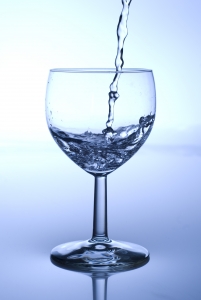 market offers more variety than ever. But what drinks are REALLY best for your body and your health? Surely it’s one of those sports drinks that bolster a mountain of scientific research showing their ability to rehydrate, right? Or maybe it’s the vitamin and mineral enhanced protein shakes that help build muscle and fuel workouts? Perhaps it’s even a more natural beverage like coconut water? Would you be surprised if you were told you that the miracle drink you’ve been looking for was one that you’ve likely had access to all your life and is essentially free? That’s right, I’m talking about good ole’ water.
market offers more variety than ever. But what drinks are REALLY best for your body and your health? Surely it’s one of those sports drinks that bolster a mountain of scientific research showing their ability to rehydrate, right? Or maybe it’s the vitamin and mineral enhanced protein shakes that help build muscle and fuel workouts? Perhaps it’s even a more natural beverage like coconut water? Would you be surprised if you were told you that the miracle drink you’ve been looking for was one that you’ve likely had access to all your life and is essentially free? That’s right, I’m talking about good ole’ water.
WHY H2O IS OFTEN THE WAY TO GO
I see it nearly each time I go to the gym. Someone hops up on the treadmill, jogs at a moderate pace for 10 minutes, hops off the treadmill, then chugs an ENTIRE sports drink.
Little do they know they just added more calories than they likely burned simply because they rehydrated inappropriately. The fact is, if you are exercising at low to moderate intensity for less than 60 minutes, water should most often be your drink of choice. For short duration exercise your body won’t have much of a need to replace the electrolytes (unless you sweat profusely) or carbs, so stick to water to rehydrate best.
Besides comparing water to other beverages from a hydration standpoint, water has no equal when it comes to these other roles it plays in the body:
- Regulating body temperature
- Lubricating joints
- Aiding the kidneys in flushing out waste
- Carrying nutrients to cells
- Helping to prevent constipation
- Moistening tissues like the eyes, mouth, and nose
WHEN OTHER DRINKS ARE BEST
If you’re exercising at a moderate or high intensity for greater than 1 hour (or if it’s particularly hot), sports drinks are a good option for replacing the lost carbs and electrolytes, especially in hot weather or if you sweat a lot. When taste is of upmost importance and hydration isn’t much of a factor, your drink of choice should be one you enjoy. Just be aware of the added calories, sugar, and other ingredients, especially if you’re trying to lose weight. Be sure to look at the ingredient list and Nutrition Facts label as well to get a clearer picture of exactly what you’re drinking.
HOW MUCH?
Each day, drinking enough water should be a priority no matter what. Aim for at least eight, 8-ounce glasses each day; more if you are working outside or participate in regular physical activity. 
Eating and Emotions: The Food-Mood Connection

While most of us realize the food we eat has a direct correlation to our physical health, many don’t consider the connection between food and our emotional state. Often we hear the phrase, “you are what you eat” but it may be just as accurate to say, “your food is your mood” as research over the years has shown what we eat can affect our mood, both positively and negatively.
This food-mood connection has been studied rather extensively with overweight and obese individuals with one theory being that eating may reduce anxiety so some overeat to reduce stress rather than listening to the body’s normal physiological hunger or satiety cues. This idea or theory is often coined as “emotional eating.” This theory, however, looks primarily at how our emotions lead us to eat and not the other way around.
So exactly how can what we eat make us feel a certain way? Many times to make the connection we need only to look back at our last meal. It probably did more than just satisfy your hunger. Likely, it also reenergized you and made you feel more alert. You were probably happier afterwards as well. The impact food can have on our mood really seems quite evident once you consider how often it plays a large role in major life events as well. After all, we already invest lots of emotion into preparing food and it is often the centerpiece behind many emotional occasions like weddings, birthdays, and holiday get-togethers.
Here are a few other ways food has been shown to affect our mood:
1. SKIPPING MEALS
This can cause you to become tired, short-tempered, nervous, jittery, afraid or confused. Why? It’s often due to hypoglycemia (low blood-sugar). When you go too long without eating your body’s blood sugar levels drop and as a result, the aforementioned emotional side-effects follow.
Helpful hint: aim to eat, whether a meal or a snack, every 3-4 hours to prevent dips in blood sugar levels.
2. HIGH-FAT MEALS
After eating meals high in fat content the most common feeling is tiredness. This is due to the fact that fat is harder for our bodies to digest and having our bodies work harder makes us feel lethargic.
Helpful hint: try to prepare meals with a balance of macronutrients (carbs, protein, and fat) to ensure a well-balanced diet.
3. LACK OF MICRONUTRIENTS
Many vitamin and mineral deficiencies are also linked to changes in our emotional health. Mood changes such as aggressiveness, hostility, hyperactivity, depression, fatigue, and irritability are often linked to B-vitamin, folic acid, magnesium, iron, zinc, or other vitamin or mineral deficiencies.
Helpful hint: eat a well-balanced diet rich in fruits, vegetables, lean protein, dairy, and whole grains. Consider a daily multivitamin if you feel your diet is not well-balanced or not adequately providing the nutrients you need.
5 #FoodSafety Tips to Keep the ILL Out of GrILLing

The grilling season is a special time often accompanied by an array of grilled treats like hotdogs, hamburgers, and barbequed chicken. But if not prepared correctly, sometimes those delicious foods can harbor harmful bacteria and spoil your feast, potentially leading to foodborne illness. 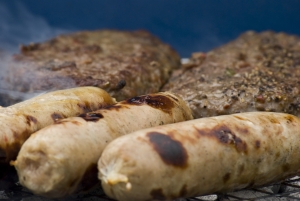
This grilling season avoid becoming one of the 76 million Americans that fall victim to foodborne illness each year and be prepared by following these 5 easy tips to food safety:
1. KEEP HOT FOODS HOT AND COLD FOODS COLD
Sounds simple enough, right? But what exactly qualifies as a safe temperature for cold foods and hot foods? The answer: follow the 40/140 rule. Keep cold foods below 40° Fahrenheit and hot foods above 140° Fahrenheit and you’ll cut down the chance for harmful bacteria to grow significantly. In order to ensure this food safety range use a thermometer as well as other necessities (coolers, ice, thermal containers, etc.) to keep hot and cold foods at their proper temperatures, especially if you’re traveling long distance with food.
2. WASH YOUR HANDS…THOROUGHLY
Another easy way to cut down on the chance of contaminating your food with harmful bacteria! But don’t just settle with a quick rinse with some luke warm water. Use soap, warm water, and be sure to wash your hands for at least 20 seconds. Try singing the ABCs in your head while your wash as a good measuring stick towards reaching the 20 second mark.
3. DON’T LET THE LEFTOVERS LINGER
It’s easy to forget about the leftovers shortly after eating a large meal, especially when hunger is no longer a concern and post-meal festivities occupy your thoughts. But this is often the time where bacteria gets its best opportunity to spoil the night (and your food). That’s because within a few hours many foods can fall within 40-140 degrees, a danger zone in which most bacteria thrive. Unfortunately, a few hours after a meal is also typically the time when people tend to pick at food for second helpings and that could lead to trouble so be sure and put the leftovers in the fridge 1-2 hours after serving to keep harmful bacteria at bay.
4. KEEP CONTACT SURFACES CLEAN
Countertops, cutting boards, plates, bowls, utensils and other containers should always be kept clean when preparing food items. In the case of raw food items, keep them as well as the containers they’re in separate from cooked or ready-to-serve items to avoid cross-contamination.
5. WHEN IN DOUBT, THROW IT OUT
If a certain food item looks, smells, or tastes suspicious don’t take any chances – just toss it. It’s much better to be safe than sorry.
WANT MORE FOOD SAFETY INFORMATION?
For more great food safety information and tips, visit these other great sites specifically aimed at fighting foodborne illness:

Today marks National Beer Day here in the United States. If we consider the fact that American’s already consume quite a bit of the brew year-round (U.S. beer sales in 2013 were over $100 billion), it’s evident that many celebrate WITH this beverage on a pretty regular basis. April 7th is the day this particular beverage is celebrated itself, however.
Why this particular day, you ask? Quite simply, this was the date in 1933 in which it was again legal to buy and sell beer after the days of prohibition and thus, an unofficial holiday ever since.
THE HEALTH BENEFITS OF BEER AND WINE
Alcohol does have potential health benefits, particularly with heart health, although the evidence is diminishing (see this USA Today editorial for more). Some studies have reported that alcoholic beverages, such as beer and wine, have been shown to increase HDL (good) cholesterol and lower LDL (bad) cholesterol. A reduction in the risk of heart attack, due to alcohol’s anticoagulant effects has also been touted.
Other benefits that moderate alcohol consumption may offer include a reduction in the risk of stroke, a lower risk of diabetes, and a lesser risk of gallstones. Besides the lowered risk of the aforementioned diseases, beer and wine also provide some nutrition. Beer, for instance does provide some vitamins such as folate, vitamin B6 and B12, niacin, pantothenic acid and riboflavin. In terms of minerals, both beer and wine offer some fluoride, magnesium, phosphorus, potassium, selenium and silicon.
Of course, it is worth noting that the nutrients and possible benefits found in alcohol can easily be obtained through other foods and beverages and the potential benefits are wiped out completely when alcohol is consumed in excess.
MODERATION IS KEY
Although alcohol does hold several possible health benefits, it’s important to point out that these benefits only stand when consumption is in moderation. What is moderate? According to the 2010 Dietary Guidelines for Americans that’s one drink per day for women and two drinks per day for men and only by adults of legal drinking age. A single drink is defined as 12 fluid ounces of regular beer (5% alcohol), 5 fluid ounces of wine (12% alcohol), or 1.5 fluid ounces of 80 proof (40% alcohol) distilled spirits.
Because alcohol consumption can be a slippery slope, it’s vital to stick to recommendations of drinking amounts in order to reap the benefits rather than over-consuming, which will wipe nearly all health benefits away.
BENEFITS VS. RISKS
If you already abstain from alcohol, keep it that way. It’s highly unlikely that any health professional would advise you start drinking to inherit the possible benefits. Many would argue (myself included) that the risks far outweigh any benefits and that abstinence is likely the best route. Here are some common risks, both immediate and long term, associated with heavy alcohol consumption:
Increased risk of:
- Hypertension
- Stroke
- Type 2 diabetes
- Upper GI cancer
- Colon cancer
- Breast cancer (even at moderate consumption)
- Impaired short-term and long-term cognitive function
RESOURCES
For more info, check out the Center for Disease Control (CDC) website on alcohol and public health or their alcohol fact sheets.
WHERE DO YOU STAND?
Have an opinion about the potential health benefits of alcohol? How about the risks? Please feel free to voice your views on the topic in the comment section.
March Marks National Nutrition Month!

March is here and [NL] is especially excited because that means it is time to celebrate National Nutrition Month® (NNM). Not familiar with this month-long celebration that highlights the importance of making informed, sound, and healthy eating choices? Here’s what YOU should know…
THE THEME
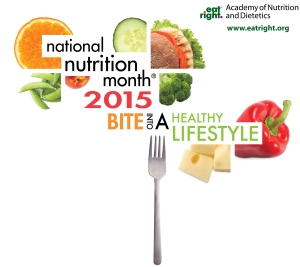
Learn more at http://www.eatright.org
This year’s theme is “Bite into a Healthy Lifestyle” which encourages us to eat foods that provide both the nutrients we need and the tastes we love as well as incorporating regular physical activity to achieve our personal health and fitness goals and promote overall health. There are so many ways to do this and below are just a few. Happy NNM!
CELEBRATE YOUR PLATE
There are many different ways to “Bite into a Healthy Lifestyle.” Here are just a few recommendations:
Make Half Your Plate Fruits and Veggies
Eating a variety of fruits and vegetables can give you the energy, fiber, vitamins and minerals needed to sustain a healthy lifestyle. Remember to incorporate a variety of color such as red, orange, green, and purple as well.
Go for Whole Grains
When eating breads, cereals, pastas, crackers, and rice try to make at least half of what you’re consuming WHOLE grains. To be sure check the ingredients list to make sure the word “whole” is included.
Stick to Low-Fat or No-Fat Dairy
Fat-free and low-fat milk contain the same amount of calcium and other essential nutrients as whole milk, but with FAR fewer calories and fat. If You are lactose intolerant, you can try lactose-free milk or a calcium-fortified soy beverage instead.
Vary Your Protein
Seafood, nuts and beans, as well as lean meat, poultry and eggs are all excellent protein sources. Be sure to vary the ways you get your protein by switching it up within these categories. Be sure and try to have a seafood protein twice a week for additional heart-health benefits provided by omega-3s.
Cut Back on the Added Sodium, Sugar, and Fat
Compare foods and choose those with lower numbers for sodium, sugar, and fat. Find healthier alternatives to adding flavor to your food such as seasoning your foods with herbs and spices instead of salt. Switch from solid fats to healthy oils like olive and canola oil. Replace sugary drinks with water and choose fruit for dessert.
Control Your Portions
Always be aware when your eating a meal or snack. Avoid mindless munching that often leads to overeating and unnecessary calorie consumption. Focus on your meals and STOP eating when you are satisfied. Use smaller plates, bowls, and glasses as an added measure.
Be Active
Adults need at least 150 minutes (that’s just 30 minutes a day, five days a week) of moderately intense physical activity each week for most health benefits. So go for a walk, bike, or jog. Go shoot some hoops, throw a pigskin around, just get out and move. No time, you say? It doesn’t all have to be done in one 30-minute chunk. Split your exercise routines into two, 30-minute or three 10-minute segments throughout the day. You can do it!
WANT TO KNOW MORE?
For more great tips and information on how YOU can “Bite into a Healthy Lifestyle” and celebrate National Nutrition Month, visit the Academy of Nutrition and Dietetics National Nutrition Month website.
5 Foods to Eat for a Heart Healthier You

The month of February is American Heart Month, which aims to bring awareness to heart health and prevention of cardiovascular disease. On a worldwide scale, CVD accounts for over 16.7 million deaths, or 29.2 percent of total deaths each year. Here in the United States, the cost of treating CVD is over 324 billion dollars.
Many of these deaths and treatment costs can be attributed to poor diet. To help prevent yourself or others from becoming try eating these heart healthy foods on a regular basis and pass the information along to a friend or family member.
1. BLUEBERRIES 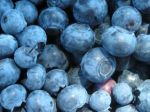
Blueberries are high in two heart healthy components: antioxidants and anti-inflammatories. The anti-inflammatory components found in blueberries can help reduce your risk of heart disease by strengthening your blood vessels against oxidative stress among other benefits.
2. OATMEAL
Oatmeal is a great way to start the day. Oatmeal is packed with fiber, which can lower you LDL (bad) cholesterol. Add some fruit like blueberries, strawberries, or a banana to give your bowl of oatmeal an antioxidant boost and some additional fiber.
3. AVOCADO 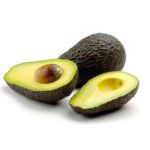
The majority of fat found in the avocado is monounsaturated, which is a heart healthy fat that has been shown to lower cholesterol. Research has also shown that avocados are rich in a natural substance called beta-sitosterol, also shown to lower cholesterol levels.
4. FLAXSEED
While studying as a dietetic intern I had the opportunity to research this particular food in great detail, and the heart health benefits are very evident. Besides being high in fiber, flaxseed is also has the richest known source of dietary lignans, which are believed to have lipid lowering effects and antioxidant properties that reduce the risk of CVD.
5. NUTS
Besides being an inexpensive and highly convenient food item, nuts such as walnuts and almonds can also help lower your LDL cholesterol and help reduce your risk of developing blood clots that could lead to a heart attack. No matter what nut you prefer, nearly all of them are a good source of unsaturated fat, plant sterols, fiber, and omega-3 fatty acids, all of which are beneficial for heart health.

Chocolate bars, jelly beans, and taffy, oh my! Since January we’ve made strides to keep a healthy diet during the year’s festivities. We limited our chocolates on Valentine’s Day, we kept Easter dinner portions a reasonable size, and we held to a one hotdog maximum on the Fourth of July. But next thing we know its October and there are unavoidable candy 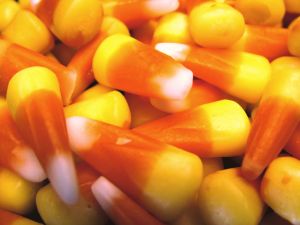 bowls tempting us everywhere we look.
bowls tempting us everywhere we look.
And while it’s okay to occasionally indulge in a bite-sized treat, the problem lies when one turns to two and two turns to…well, you get the idea. Eventually, we find ourselves with unintentional weight gain and it’s not even Thanksgiving yet! Meanwhile, the threat of an increase in hyperactivity and cavities in our children is giving us a bigger headache than our neighbor’s talking pumpkin.
Like in all things health and nutrition, careful planning is the key. Nutrition Lately has pulled together some simple tricks to help you and your family successfully ‘treat’ this Halloween.
TRICK: PREPARE THE TROOPS
Eating a healthy meal pre-‘trick-or-treating’ is your first defense against overindulging later. We often turn to candy first because our blood sugar is low and as a result we feel hungry. Before leaving home, serving a high-protein, high-fiber meal for you and family should keep temptations at bay for the next 2-3 hours.
A suggestion would be grilled chicken breast, wholegrain rice, broccoli florets, a glass of skim milk, and apple slices for dessert. Drinking plenty of water is also important for keeping cravings at bay. Revert back to your MyPlate guide for other suggestions and tips.
TRICK: BE THE NEIGHBORHOOD HERO
There are several alternatives to passing out candy on Halloween. Here are some suggestions that will make your neighbors both admire you and think twice about what they hand out next year:
- Mini Toothbrushes
- Halloween stickers
- Rubber Balls
- Party Favors
- Colored Pencils
- Raisins Packets
- Key Chains
TRICK: SET A POST-TREATING PLAN
When kids get home from trick-or-treating, allow them to use their newly acquired candy as a sort of currency. First, have kids pile through and choose favorites and non-favorites. Then, make a wager with them that for every piece of candy they fork over they get a penny or nickel. Then kids can use their newly acquired money to buy something (non-food focused) at the store. With the candy that is left, be sure to immediately stash out of sight. Allow kids to choose one piece a day and preferably after a meal.
TRICK: MAKE THE BEST CHOICES
Not all candy is created equal. When you do indulge, try to pick out the lowest calorie and sugar options available. Check out our list for some suggestions:
CHOCOLATE
- 3 Musketeers Miniatures- 24 calories– WINNER!
- Milky Way Mini- 28 calories
- Snicker Mini- 42.5 calories
- Two Twix Bars- 160 calories
- Peanut Butter Pumpkin- 180 calories
- Almond Joy/Mounds- 200 calories
OTHER TIPS
- Include dark chocolate when possible for an antioxidant boost
- Choose hard candies, which you can’t eat as quickly
- Opt for the sugar-free candies, if provided
For more nutrition tips, suggestions and family friendly recipes, visit Kids Eat Right.
Tips to Having a Heart-Healthy Valentine’s Day

Right smack dab in the midst of American Heart Month and just more than a month after our New Year’s resolutions to eat healthier and exercise more comes yet another holiday that threatens to sabotage all progress made: St. Valentine’s  Day.
Day.
Dinner invitations and chocolate-infested work places can easily distract us from our daily healthy eating plans. In light of the American Heart Health month Nutrition Lately has put together a heart healthy action plan to help lighten the load, literally, this Valentine’s Day.
WHAT MAKES A HEART HEALTHY?
Heart disease is the number one cause of death for the American population. This is because the disease is often tied to several other health risks such as high cholesterol, diabetes, and high blood pressure.
The American Heart Association recommends a combination of good nutrition, physical activity, smoking cessation, and stress management to be truly armed against this disease. Here are some staples of the heart healthy DASH (Dietary Approaches to Stop Hypertension) diet:
- Consume less than 2,300 mg of sodium a day
- Consume 6-8 servings of grains a day. Make half of the grains whole grains.
- Consume 4-5 servings of both fruits and vegetables a day. Get a variety!
- Consume 2-3 servings of dairy a day. Choose low-fat options.
- Choose lean meats, poultry and fish.
- Add nuts, seeds, and legumes to your meals.
[NL] VALENTINE’S DAY ACTION PLAN
Start out with a healthy breakfast…
You’ve probably heard at least once before that breakfast is the most important meal of the day. Well, it’s the truth. Eating a nutritious, protein and fiber-packed breakfast not only starts our metabolic engines, it helps us to avoid over eating later in the day which is especially important on a day like St. Valentine’s Day.
[NL] Tip: Start V-Day nutritiously: We recommend a delicious bowl of oatmeal. Oatmeal is packed with soluble fiber which binds like a gel to cholesterol to help flush it out of our bodies We like One Hungry Mama’s suggestions for turning oatmeal into an appetizing way to start the day.
Dining Out…
Dining out is often fun and romantic part of Valentine’s Day. Unfortunately, because someone else is preparing our food, we do not know exactly what is going into the preparation. Restaurant food often has hidden artery-clogging saturated fats, trans fat and cholesterol.
[NL] Tip: Choose the right restaurant: Avoid restaurants that offer all-you-can-eat buffets because this often leads to over-consumption of fat and calories.
[NL] Tip: Decode the menu: Words like au gratin, fried, sautéed and buttered should be clues that your meal will be prepared in fat. Opt for menu options with the words grilled, broiled, or roasted. Also, ask your server how foods are prepared and what ingredients they contain. Most restaurants are happy to prepare food to order to keep your business.
[NL] Tip: When all else fails, share. Sharing is caring, especially when it comes to matters of the heart. So this Valentine’s Day if you must indulge in high calorie dining options, such as steak or chocolate cake, share with the table. An easy way to keep portions in check is to start with dinner salads and share a main entrée and/or dessert.
SWEET TREATS OR HEALTHY INDULGENCES?
Whether it’s the lingering candy bowl at the office, dinner out or our own home-baked treats, less-than-healthy temptations have us surrounded on Valentine’s Day. Here’s our heart healthy advice on common indulgences:
- Chocolate: Though chocolate has a bad rep for being high in fat and sugar, research has linked cocoa and the flavonoids in dark chocolate to heart health. Opt for the darker pieces in that box of chocolates.
- Alcohol: It is important to avoid over consumption of alcohol because it can raise the levels of some fats in the blood stream called triglycerides. However, studies have shown that there are potential benefits to the heart found in red wine called antioxidants. Skip the cocktails and choose a cabernet or merlot.
- Baked Goods: Are you the type who likes to bake goodies for your loved ones? We suggested some healthy alternatives to some popular recipes. Check out these recipes for baby tiramisu, chocolate bliss marble cake, and Strawberry Schaum Torte.
Whether you’re a seasoned health pro or just kick-starting healthy lifestyle changes, it’s important to know the facts that will protect you and your family against heart disease. Visit www.heart.org up-to-date resources for weight management, healthy eating, and physical health. Have a happy, healthy Valentine’s Day!
Coffee Drinkers Have More than One Reason to Perk Up

Whether you drink it to get a lift each morning, to maintain focus during a late-night study session or simply to enjoy the taste, coffee (and the caffeine found in it) has long been documented for its stimulating effects. But that’s not the only benefit coffee can provide – that’s good news for the millions around the world who drink it, including the estimated 83% of adults in America1.
Recently, a study examined the effect of caffeine and memory. Specifically, the human brain’s ability to discriminate between similar but non-identical images or items in a process known as pattern separation. During the study, participants studied a series of images and were then either given a placebo or a 200-milligram caffeine tablet (about the equivalent amount found in a cup of coffee) five minutes later.

The researchers ultimately found that caffeine appears to have the cognitive-enhancing ability to improve certain memories at least up to 24 hours after consumption.
In another recent study, researchers debunked the popular wives’ tale that caffeinated beverages, including coffee, can lead to dehydration even at moderate consumption due to the diuretic effect of caffeine. The results of this study, although noted to be limited in its design by the researchers themselves, concluded that caffeine in moderate amounts (up to four cups per day) did not pose a detrimental effect in regards to hydration status and was actually quite similar to that of water.
Among the other health benefits coffee can potentially provide include a reduced risk of stroke2, lowered risk of type II diabetes3, protection from cognitive impairment such as Alzheimer’s disease and dementia4, as well as a decreased risk of certain types of cancer5.
References
- “Home – National Coffee Association.” Home – National Coffee Association. N.p., n.d. Web. 13 Jan. 2014. <http://www.ncausa.org/i4a/pages/index.cfm?pageID=731>.
- Kokubo, Yoshihiro . “The Impact of Green Tea and Coffee Consumption on the Reduced Risk of Stroke Incidence in Japanese Population: The Japan Public Health Center-Based Study Cohort.”Stroke 44 (2013): n. pag. Stroke. Web. 13 Jan. 2014.
- van Dam, Rob, and Frank Hu. “Coffee Consumption and Risk of Type 2 Diabetes A Systematic Review .” The Journal of the American Medical Association 294.1 (2005): 97. JAMA. Web. 13 Jan. 2014.
- Eskelinen, Marjo, and Miia Kivipeltoa. “Caffeine as a Protective Factor in Dementia and Alzheimer’s Disease.” Journal of Alzheimer’s Disease 20 (2010): S167–S174. Print.
- Sinha, Rashmi, and Amanda Cross. “Caffeinated and decaffeinated coffee and tea intakes and risk of colorectal cancer in a large prospective study.” The American Journal of Clinical Nutrition 99.1 (2012): n. pag. The American Journal of Clinical Nutrition. Web. 13 Jan. 2014.





